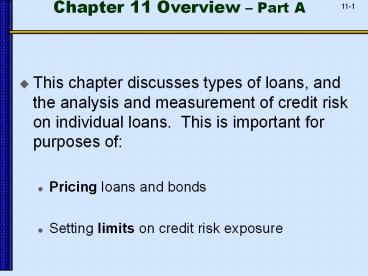Chapter 11 Overview - PowerPoint PPT Presentation
1 / 32
Title:
Chapter 11 Overview
Description:
Default of one major borrower can have significant impact on value and reputation of many FIs ... affected by competitive conditions and usury ceilings ... – PowerPoint PPT presentation
Number of Views:14
Avg rating:3.0/5.0
Title: Chapter 11 Overview
1
Chapter 11 Overview Part A
- This chapter discusses types of loans, and the
analysis and measurement of credit risk on
individual loans. This is important for purposes
of - Pricing loans and bonds
- Setting limits on credit risk exposure
2
Introduction To Credit Risk
- Forms of credit risk
- Where do banks face credit risk?
- Performance
- Impact on bank profits
- Accounting
- Methods of measuring/Monitoring Risk
3
Methods of Measuring/Monitoring Risk
- Linear-Discriminant Models
- Probability-based
- Term Structure of Credit Risk
- Option-based models
- Value the default option
- Loan value balance option value
- Merton-Miller 1970s
- Only implemented recently
- Key Equipment Financial uses this
4
Forms of Credit Risk
- Default
- Down-grade
- Spread
5
Where Banks Face Credit Risk
- Loans
- Usually secured
- Loan Commitments
- Letters of Credit
- Derivative positions (fundamental)
- Counter-party risk
6
Default does not 100 loss
- Often, some amount is recovered
- Estimate loss EDF x (1-recovery rate)
7
How Loan Losses Impact Banks
- Expense loan loss costs each period
- Allowance for loan losses
- Loan loss reserve
- Charge-off a loan
- Loan loss reserve
- Loan Balances
- Note trends in allowance and adequacy of reserves
versus loans outstanding
8
Performance
- Varies by loan type and lending quality
- Some aggregate Data
9
Credit Quality Problems
- Historical problems with
- junk bonds
- LDC loans
- farm mortgage loans
- Commercial real estate loans
- Crises in Asian countries such as Korea,
Indonesia, Thailand, and Malaysia.
10
Credit Quality Problems
- Current problems
- Sub-prime mortgages
- Spreading to prime mortgages
- Economic recession impacting
- Credit Card loans
- Auto loans
- Commercial Industrial loans at normal
recession levels so far
11
Credit Quality Problems
- Default of one major borrower can have
significant impact on value and reputation of
many FIs - Emphasizes importance of managing credit risk
12
Credit Quality Problems
- New types of credit risk related to loan
guarantees and off-balance-sheet activities. - Increased emphasis on credit risk evaluation.
13
Types of Loans
- CI loans secured and unsecured
- Solo or syndication
- Spot loans, Loan commitments
- Decline in CI loans originated by commercial
banks and growth in commercial paper market. - Downgrades of Ford, General Motors and Tyco
- RE loans primarily mortgages
- Fixed-rate, ARM
- Mortgages can be subject to default risk when
loan-to-value increases. - HELs
- Commercial RE loans totally separate market
14
Consumer loans
- Individual (consumer) loans personal, auto,
credit card. - Nonrevolving loans
- Automobile, mobile home, personal loans
- Growth in credit card debt
- Visa, MasterCard
- Proprietary cards such as Sears, ATT
- Consolidation among credit card issuers
- Bank of America MBNA
- Risks affected by competitive conditions and
usury ceilings - Bankruptcy Reform Act of 2005
15
Other loans
- Other loans include
- Farm loans
- Other banks
- Nonbank FIs
- Broker margin loans
- Foreign banks and sovereign governments
- State and local governments
16
Recall Bank Balance Sheets from Ch 2
17
Impact of Securities Markets on Banks
- 2 trillion Commercial paper
- 2 trillion Investment grade bonds
- 4 trillion Residential mortgages
- Also
- Auto loans
- Credit card balances
- Commercial real estate loans
- Even commercial loans themselves!
18
(No Transcript)
19
Loan Growth and Asset Quality
20
Annual Net Charge-Off Rates on Loans
21
(No Transcript)
22
(No Transcript)
23
(No Transcript)
24
(No Transcript)
25
(No Transcript)
26
(No Transcript)
27
(No Transcript)
28
(No Transcript)
29
(No Transcript)
30
(No Transcript)
31
(No Transcript)
32
Moodys Default Rates 1920-2006
Investment Grade Investment Grade High Yield High Yield
Original Re-weighted Original Re-weighted
Mean .146 1.52 2.69 4.34
Worst Single Year 1.55 1.66 15.90 23.50
Worst 3-Year Period 0.89 0.94 11.35 14.15
Worst 6-Year Period 0.88 0.91 8.13 11.30
Worst 3 Years 1.20 1.28 12.26 20.50































